Eyal Shnarch
Guided Query Refinement: Multimodal Hybrid Retrieval with Test-Time Optimization
Oct 06, 2025Abstract:Multimodal encoders have pushed the boundaries of visual document retrieval, matching textual query tokens directly to image patches and achieving state-of-the-art performance on public benchmarks. Recent models relying on this paradigm have massively scaled the sizes of their query and document representations, presenting obstacles to deployment and scalability in real-world pipelines. Furthermore, purely vision-centric approaches may be constrained by the inherent modality gap still exhibited by modern vision-language models. In this work, we connect these challenges to the paradigm of hybrid retrieval, investigating whether a lightweight dense text retriever can enhance a stronger vision-centric model. Existing hybrid methods, which rely on coarse-grained fusion of ranks or scores, fail to exploit the rich interactions within each model's representation space. To address this, we introduce Guided Query Refinement (GQR), a novel test-time optimization method that refines a primary retriever's query embedding using guidance from a complementary retriever's scores. Through extensive experiments on visual document retrieval benchmarks, we demonstrate that GQR allows vision-centric models to match the performance of models with significantly larger representations, while being up to 14x faster and requiring 54x less memory. Our findings show that GQR effectively pushes the Pareto frontier for performance and efficiency in multimodal retrieval. We release our code at https://github.com/IBM/test-time-hybrid-retrieval
An Analysis of Hyper-Parameter Optimization Methods for Retrieval Augmented Generation
May 06, 2025Abstract:Finding the optimal Retrieval-Augmented Generation (RAG) configuration for a given use case can be complex and expensive. Motivated by this challenge, frameworks for RAG hyper-parameter optimization (HPO) have recently emerged, yet their effectiveness has not been rigorously benchmarked. To address this gap, we present a comprehensive study involving 5 HPO algorithms over 5 datasets from diverse domains, including a new one collected for this work on real-world product documentation. Our study explores the largest HPO search space considered to date, with two optimized evaluation metrics. Analysis of the results shows that RAG HPO can be done efficiently, either greedily or with iterative random search, and that it significantly boosts RAG performance for all datasets. For greedy HPO approaches, we show that optimizing models first is preferable to the prevalent practice of optimizing sequentially according to the RAG pipeline order.
The Mighty ToRR: A Benchmark for Table Reasoning and Robustness
Feb 26, 2025



Abstract:Despite its real-world significance, model performance on tabular data remains underexplored, leaving uncertainty about which model to rely on and which prompt configuration to adopt. To address this gap, we create ToRR, a benchmark for Table Reasoning and Robustness, that measures model performance and robustness on table-related tasks. The benchmark includes 10 datasets that cover different types of table reasoning capabilities across varied domains. ToRR goes beyond model performance rankings, and is designed to reflect whether models can handle tabular data consistently and robustly, across a variety of common table representation formats. We present a leaderboard as well as comprehensive analyses of the results of leading models over ToRR. Our results reveal a striking pattern of brittle model behavior, where even strong models are unable to perform robustly on tabular data tasks. Although no specific table format leads to consistently better performance, we show that testing over multiple formats is crucial for reliably estimating model capabilities. Moreover, we show that the reliability boost from testing multiple prompts can be equivalent to adding more test examples. Overall, our findings show that table understanding and reasoning tasks remain a significant challenge.
Benchmark Agreement Testing Done Right: A Guide for LLM Benchmark Evaluation
Jul 18, 2024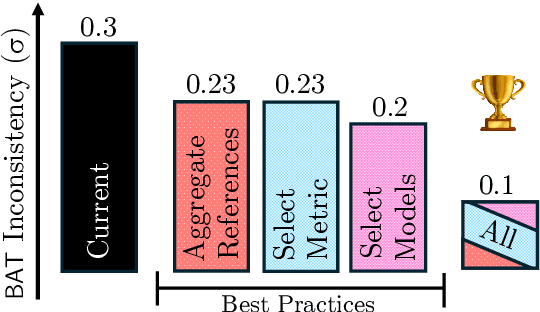
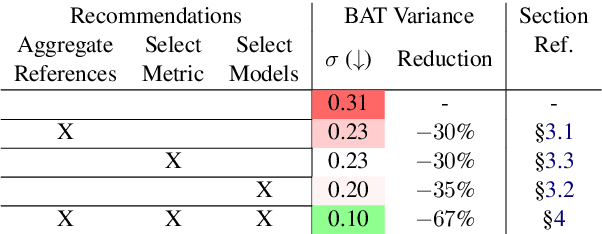
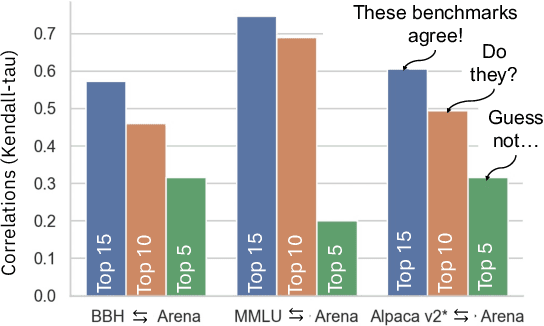
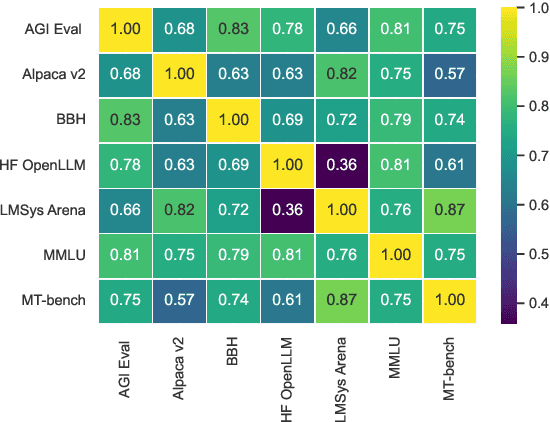
Abstract:Recent advancements in Language Models (LMs) have catalyzed the creation of multiple benchmarks, designed to assess these models' general capabilities. A crucial task, however, is assessing the validity of the benchmarks themselves. This is most commonly done via Benchmark Agreement Testing (BAT), where new benchmarks are validated against established ones using some agreement metric (e.g., rank correlation). Despite the crucial role of BAT for benchmark builders and consumers, there are no standardized procedures for such agreement testing. This deficiency can lead to invalid conclusions, fostering mistrust in benchmarks and upending the ability to properly choose the appropriate benchmark to use. By analyzing over 40 prominent benchmarks, we demonstrate how some overlooked methodological choices can significantly influence BAT results, potentially undermining the validity of conclusions. To address these inconsistencies, we propose a set of best practices for BAT and demonstrate how utilizing these methodologies greatly improves BAT robustness and validity. To foster adoption and facilitate future research,, we introduce BenchBench, a python package for BAT, and release the BenchBench-leaderboard, a meta-benchmark designed to evaluate benchmarks using their peers. Our findings underscore the necessity for standardized BAT, ensuring the robustness and validity of benchmark evaluations in the evolving landscape of language model research. BenchBench Package: https://github.com/IBM/BenchBench Leaderboard: https://huggingface.co/spaces/per/BenchBench
Label-Efficient Model Selection for Text Generation
Feb 12, 2024
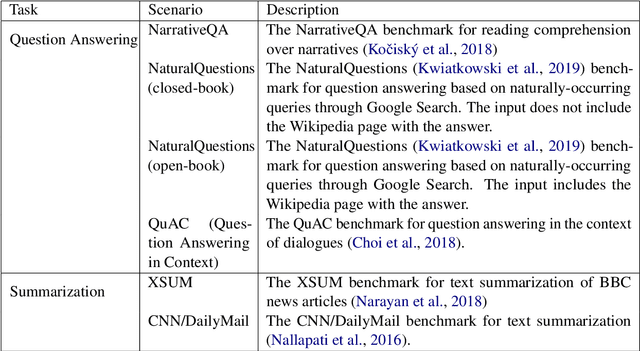
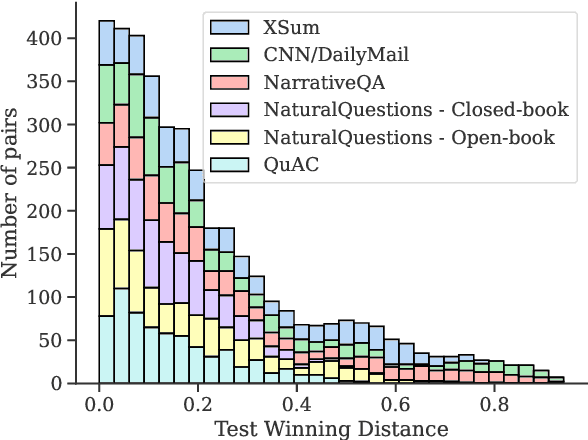

Abstract:Model selection for a given target task can be costly, as it may entail extensive annotation of the quality of outputs of different models. We introduce DiffUse, an efficient method to make an informed decision between candidate text generation models. DiffUse reduces the required amount of preference annotations, thus saving valuable time and resources in performing evaluation. DiffUse intelligently selects instances by clustering embeddings that represent the semantic differences between model outputs. Thus, it is able to identify a subset of examples that are more informative for preference decisions. Our method is model-agnostic, and can be applied to any text generation model. Moreover, we propose a practical iterative approach for dynamically determining how many instances to annotate. In a series of experiments over hundreds of model pairs, we demonstrate that DiffUse can dramatically reduce the required number of annotations -- by up to 75% -- while maintaining high evaluation reliability.
Genie: Achieving Human Parity in Content-Grounded Datasets Generation
Jan 25, 2024Abstract:The lack of high-quality data for content-grounded generation tasks has been identified as a major obstacle to advancing these tasks. To address this gap, we propose Genie, a novel method for automatically generating high-quality content-grounded data. It consists of three stages: (a) Content Preparation, (b) Generation: creating task-specific examples from the content (e.g., question-answer pairs or summaries). (c) Filtering mechanism aiming to ensure the quality and faithfulness of the generated data. We showcase this methodology by generating three large-scale synthetic data, making wishes, for Long-Form Question-Answering (LFQA), summarization, and information extraction. In a human evaluation, our generated data was found to be natural and of high quality. Furthermore, we compare models trained on our data with models trained on human-written data -- ELI5 and ASQA for LFQA and CNN-DailyMail for Summarization. We show that our models are on par with or outperforming models trained on human-generated data and consistently outperforming them in faithfulness. Finally, we applied our method to create LFQA data within the medical domain and compared a model trained on it with models trained on other domains.
Efficient Benchmarking (of Language Models)
Aug 31, 2023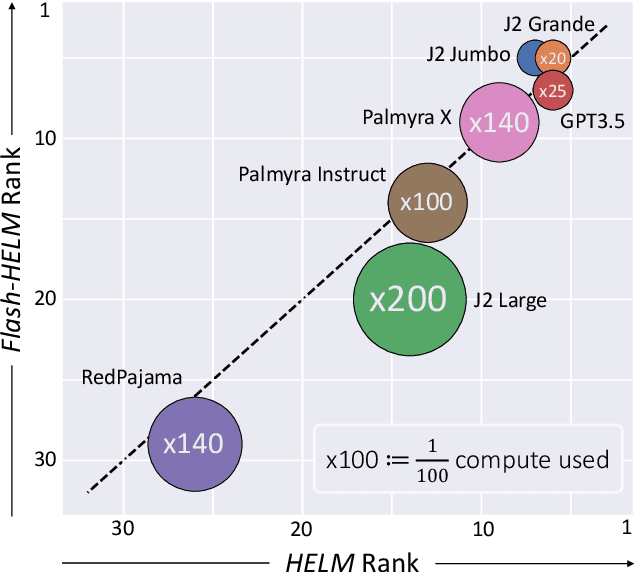
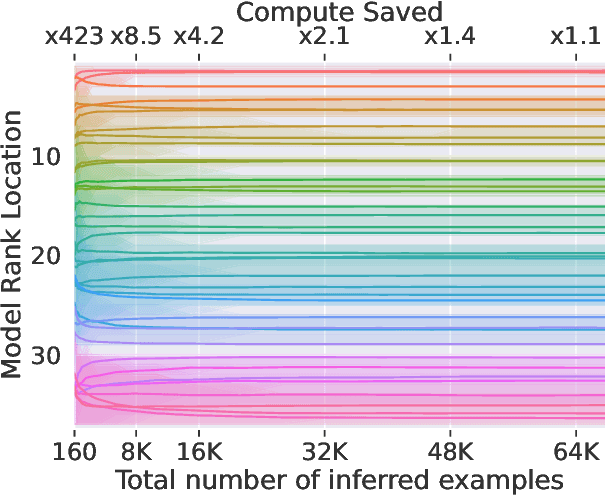
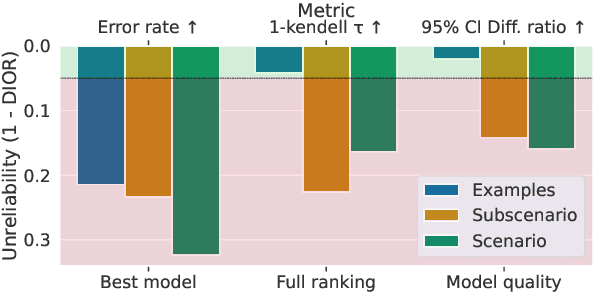
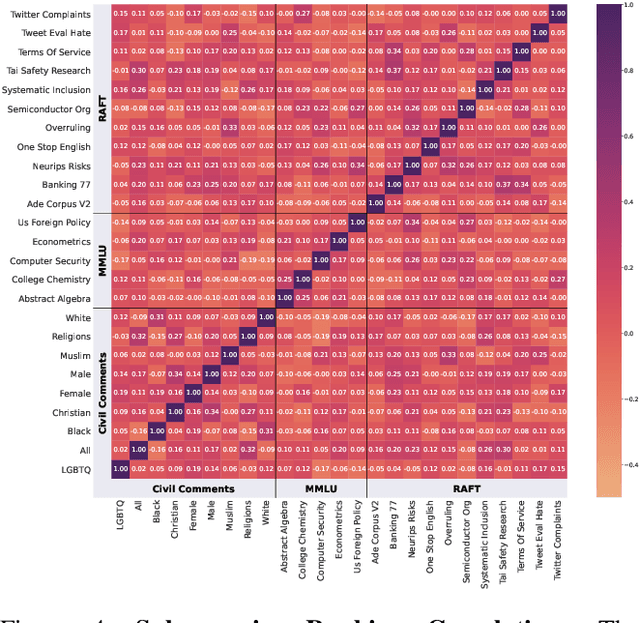
Abstract:The increasing versatility of language models LMs has given rise to a new class of benchmarks that comprehensively assess a broad range of capabilities. Such benchmarks are associated with massive computational costs reaching thousands of GPU hours per model. However the efficiency aspect of these evaluation efforts had raised little discussion in the literature. In this work we present the problem of Efficient Benchmarking namely intelligently reducing the computation costs of LM evaluation without compromising reliability. Using the HELM benchmark as a test case we investigate how different benchmark design choices affect the computation-reliability tradeoff. We propose to evaluate the reliability of such decisions by using a new measure Decision Impact on Reliability DIoR for short. We find for example that the current leader on HELM may change by merely removing a low-ranked model from the benchmark and observe that a handful of examples suffice to obtain the correct benchmark ranking. Conversely a slightly different choice of HELM scenarios varies ranking widely. Based on our findings we outline a set of concrete recommendations for more efficient benchmark design and utilization practices leading to dramatic cost savings with minimal loss of benchmark reliability often reducing computation by x100 or more.
The Benefits of Bad Advice: Autocontrastive Decoding across Model Layers
May 02, 2023



Abstract:Applying language models to natural language processing tasks typically relies on the representations in the final model layer, as intermediate hidden layer representations are presumed to be less informative. In this work, we argue that due to the gradual improvement across model layers, additional information can be gleaned from the contrast between higher and lower layers during inference. Specifically, in choosing between the probable next token predictions of a generative model, the predictions of lower layers can be used to highlight which candidates are best avoided. We propose a novel approach that utilizes the contrast between layers to improve text generation outputs, and show that it mitigates degenerative behaviors of the model in open-ended generation, significantly improving the quality of generated texts. Furthermore, our results indicate that contrasting between model layers at inference time can yield substantial benefits to certain aspects of general language model capabilities, more effectively extracting knowledge during inference from a given set of model parameters.
Zero-Shot Text Classification with Self-Training
Oct 31, 2022



Abstract:Recent advances in large pretrained language models have increased attention to zero-shot text classification. In particular, models finetuned on natural language inference datasets have been widely adopted as zero-shot classifiers due to their promising results and off-the-shelf availability. However, the fact that such models are unfamiliar with the target task can lead to instability and performance issues. We propose a plug-and-play method to bridge this gap using a simple self-training approach, requiring only the class names along with an unlabeled dataset, and without the need for domain expertise or trial and error. We show that fine-tuning the zero-shot classifier on its most confident predictions leads to significant performance gains across a wide range of text classification tasks, presumably since self-training adapts the zero-shot model to the task at hand.
Label Sleuth: From Unlabeled Text to a Classifier in a Few Hours
Aug 02, 2022



Abstract:Text classification can be useful in many real-world scenarios, saving a lot of time for end users. However, building a custom classifier typically requires coding skills and ML knowledge, which poses a significant barrier for many potential users. To lift this barrier, we introduce Label Sleuth, a free open source system for labeling and creating text classifiers. This system is unique for (a) being a no-code system, making NLP accessible to non-experts, (b) guiding users through the entire labeling process until they obtain a custom classifier, making the process efficient -- from cold start to classifier in a few hours, and (c) being open for configuration and extension by developers. By open sourcing Label Sleuth we hope to build a community of users and developers that will broaden the utilization of NLP models.
 Add to Chrome
Add to Chrome Add to Firefox
Add to Firefox Add to Edge
Add to Edge